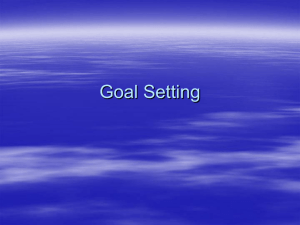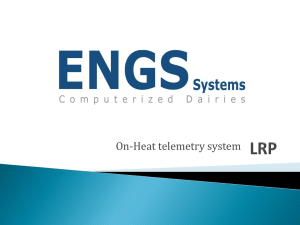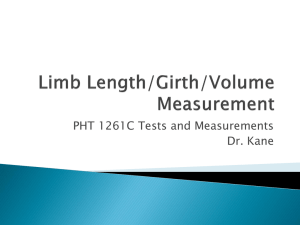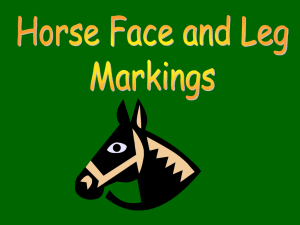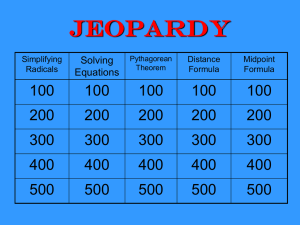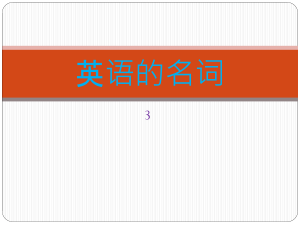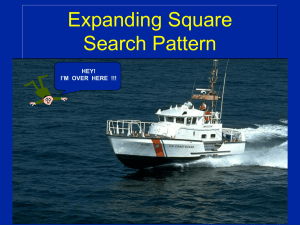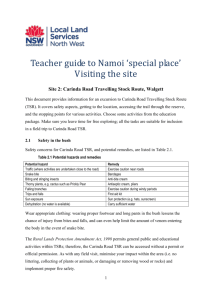sabot search patterns
advertisement
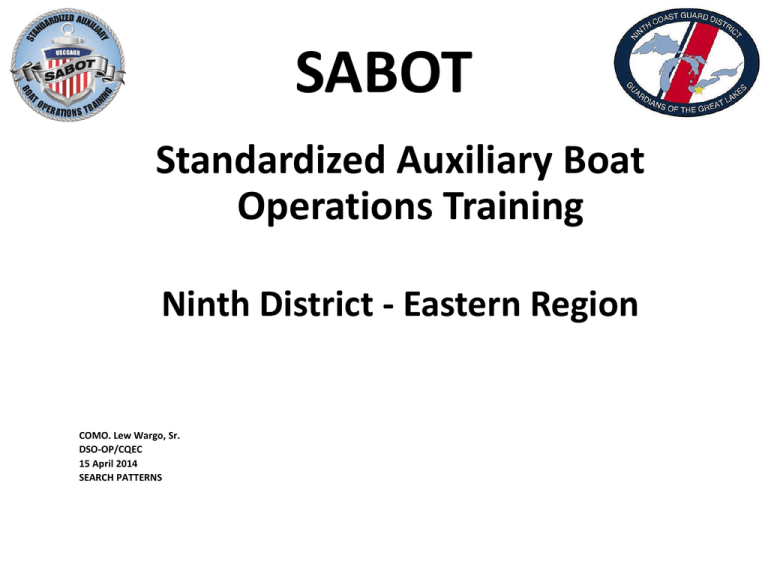
SABOT Standardized Auxiliary Boat Operations Training Ninth District - Eastern Region COMO. Lew Wargo, Sr. DSO-OP/CQEC 15 April 2014 SEARCH PATTERNS SABOT SEARCH PATTERNS TERMINAL PERFORMANCE OBJECTIVE: Students given a SAROPS generated search action plan (SAP), without prompting or use of references, pilot a single unit search pattern (select one commonly used in their AOR). Any may be used but, suggest using the Sector (VS), Expanding Square (SS) or Barrier (BS) patterns which are the most likely to be run by a small Aux. facility. SEARCH PATTERNS REFERENCES • Boat Crew Seamanship Manual, COMDTINST M16114.5(series) • (AUXSC&E) course • Auxiliary Boat Crew Qualification Guide, COMDTINST M16794.52(series) • SABOT Job Aid (Section G) • D9 SAR Plan, Addendum to NSS TERMINAL PERFORMANCE OBJECTIVE: Plot & execute those used in the AOR: • Sector Search (VS) • Expanding Square (SS) • Parallel Track (PS) • Creeping Line (CS) • Track Line Return (TSR) and Non-return TSN) • Barrier (BS) (used in a strong current area) SEARCH PATTERNS THE FIRST LETTER INDICATES THE PATTERN TYPE: C P S T V B Creeping Line Parallel Track Expanding Square Track-line Sector Barrier SEARCH PATTERNS THE SECOND LETTER INDICATES SINGLE OR MULTIPLE UNIT: S Single Unit M Multi-Unit SEARCH PATTERNS THE THIRD LETTER (IF USED) INDICATES SPECIALIZED PATTERN INSTRUCTIONS: R N Return Non-Return PATTERN CALCULATOR • A hand operated wheel type calculator for determining headings and distances for drifting search patterns (VS and SS). May be ordered from the Federal Stock System as: • Stock Number SN 7530-01-GF2-9010 CALCULATOR for “VS” • Search Pattern calculator (Course Leg Identifier) for a Sector Search Pattern. CACULATOR for “SS” • Search Pattern Calculator (Course Leg Identifier) for Expanding Square Pattern. SECTOR PATTERN Used when there is a high degree of confidence & the target is difficult to detect, (PIW). The (SRU) passes through datum several times, increasing the chance of discovery. The pattern resembles the spokes of a wagon wheel with the center being datum. Datum must be marked by the first SRU on scene with a marker buoy. SECTOR PATTERN The first leg is always run in the direction of drift. If drift can not be determined first leg should be “OOO” degrees TRUE. EXPANDING SQUARE This is a drifting search pattern. Used when the last known position of a search object has a High degree of accuracy, the search area is small, and a concentrated search is desired. One Track space is added to every other leg. All turns Are 90 degrees to the right. EXPANDING SQUARE The first leg is always run in the direction of drift. If drift can not be determined first leg should be “OOO” degrees TRUE PARALLEL TRACK This precision search pattern is used when there is an equal probability that the search object could be anywhere in the search area. It is a good pattern to use when the approximate location of the search object is known and a uniform coverage is desired. PARALLEL TRACK • The Search area is usually a rectangle shape and the CSP is 1/2 Track Space TS in from a corner. The first leg is run parallel to the long (major) axis of the pattern. The short legs are all one TS long. If this is run with multiple SRUs then all short legs are 1 TS times the number of SRUs. PARALLEL TRACK CREEPING LINE This is a precision search pattern used when the probable location of the search object has been determined to be more likely at one end of the search area. The search runs are run across the minor axis of the search area and after each run the SRU moves 1 TS along the major axis. The start (CSP) and all turns are 1/2 TS from the edge of the search area. CREEPING LINE (CS) TRACK LINE • A precision search pattern. It is used when the only information available on the search object is the intended course of the search object. This can be run along the track line with no return (TSN) or with a return (TSR). The TSR is run 1/2 TS to the right of the track line in each direction. TRACK LINE (TSR) BARRIER SEARCH • The Barrier pattern is used in areas with strong current, such as in a river. The search lies along the path of the current. The search unit moves back and forth over the same track allowing the object to drift to it. This may be run with one SRU (BS) or multiple SRUs (BM). ENABLING OBJECTIVES: A. Plot each of the following: • Single Unit Sector Search (VS) • Single Unit Expanding Square (SS) • Single Unit Parallel Track (PS) • Single Unit Creeping Line (CS) • Single Unit Track Line Return (TSR) • Single Unit Track Line Non-return (TSN) ENABLING OBJECTIVES: B. Label each pattern C. Calculate the time to complete each search pattern and the time for each leg. ENABLING OBJECTIVES: For SS and VS PATTERNS: D. Prepare the search pattern for execution E. Brief the crew on the mission and assign tasking. F. Demonstrate arriving within 100 yards of the CSP. ENABLING OBJECTIVES: G. Demonstrate advising the SAR Mission Controller (SMC) (the Instructor for this exercise) of the OnScene weather and start time. H. Determine the initial on scene set and drift and adjust first leg of search (if applicable). ENABLING OBJECTIVES: I. J Demonstrate running the first leg within 5 degrees of the actual direction of set and drift. Demonstrate the use of the Course Leg Identifier/Search Pattern Computer (if applicable). ENABLING OBJECTIVES: K. Demonstrate safely navigating the vessel utilizing all electronics. L. Demonstrate calculating actual on-scene set and drift. M. Demonstrate advising the SMC (Instructor) of completion of the pattern and results.

